Massachusetts Towns in the Civil War, ca 1861-1865
Wayland, MA as
a Case Study
A Unit for
middle and high school students

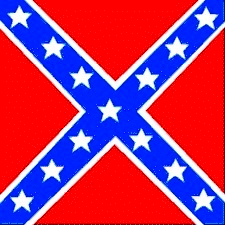
Overview:
The Civil War between the North and the South was so costly
in terms of lives lost, dollars spent and lands destroyed, that it remains a
painful topic to study. Because there is so much information available,
students can become overwhelmed. A local perspective can provide a needed
focus. The Local Studies Center (LSC) of the Wayland Historical Society decided
to provide local schools with curriculum materials to help students look at the
war from a community point of view. By locating the soldiers’ neighborhoods and
gravesites, and their letters from battlefields and hospitals, as well as
townspeople’s activities related to the home front, the war becomes more
meaningful and relevant to student lives. The proposed unit brings the war home
by asking such questions as:
How did the Civil War affect daily lives?
Š How
did the commitment to fight against the South begin? What did townspeople think
the war was about?
Š Did
Mass. towns have a say about quotas of troops to supply to the war? Were there
people opposed to sending troops?
Š How
did townspeople get war news? Did their views change during the four bloody
years of battles and deaths?
Š What evidence is there for pro- or anti-slavery views? Was there ever slavery in
the town?
Š Who served in the Union armed forces and what happened to these men?
Š What
did the people at home do to support the war effort and what sacrifices did
they make?
Š What
did townspeople do for the returning soldiers and families who lost relatives?
Š What
were the after-effects of the war?
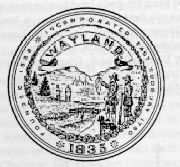
In a partnership with the public schools (upper elementary),
the Local Studies Center (LSC) of the Wayland Historical Society developed a
Civil War Unit with study materials for the classroom, a local Civil War bus
tour and a culminating event at Society headquarters—a Reunion Celebration
for the men who served in the war. For several years the success of this Unit
was dependent on the leadership of Nancy Ashkar, who organized the study
materials, provided teacher training in their use, and supervised the classroom
and field trip activities. With her untimely death in 2004, this program has
been halted and the valuable curriculum materials she created remain in boxes.
The Massachusetts Studies Project at the University of
Massachusetts Boston suggested that the Unit could be made more useful, not
just to Wayland teachers but to any interested educators, by providing a model
to be accessed online. This is now being offered as a model aimed at middle and
high school students rather than elementary, but the materials can be adapted
for younger ages.
How can this Unit be used by any Community?
If you localize the Unit with information on your own
community, this curriculum makes suggestions as the lessons proceed. Wayland is
extremely lucky to have a historical society ready and willing to provide basic
research materials for the classroom and to invite classes to the Society house
museum, and this may be unusual. At the least you will be able to locate a
representative of the community, versed in the town's history, who can share
knowledge about Civil War involvement and research references. Community
historical commissions are another good place to seek local history
specialists, and many local libraries have excellent local history collections
and well-informed librarians. A more detailed summary of sources is contained
in the Bibliography at the end of the Unit.
Selection of Civil War Characters for Research/Role Play
 The LSC chose a post-war Reunion Party as
a vehicle for role playing Civil War “Town Characters”— the service
men and the townspeople who represented different aspects of the community
involvement. The selection of specific characters depended on the quantity
and quality of information available through town histories and Society archives
on local families and events. Basic documents from the period that relate
to all characters were sought as well as specific documents and artifacts
that help flesh out the selected character. Wayland was also fortunate in
having a superb reference on the men who served in the War, Town of Wayland
in the Civil War of 1861-1865, (hereafter called Memorial). This Unit includes the Wayland list of Civil War
Characters and a brief summary of their role during the Civil War, and the
contents of the Character’s Role Play packet, If your local history society
is not available to help assemble character packets, start on a small scale.
With the assistance of student research, the number of characters and quality
of research will grow. Students can initiate the project to uncover the characters
and scenes that make the role of their town in the Civil War come to life,
and community partners will respond to their call.
The LSC chose a post-war Reunion Party as
a vehicle for role playing Civil War “Town Characters”— the service
men and the townspeople who represented different aspects of the community
involvement. The selection of specific characters depended on the quantity
and quality of information available through town histories and Society archives
on local families and events. Basic documents from the period that relate
to all characters were sought as well as specific documents and artifacts
that help flesh out the selected character. Wayland was also fortunate in
having a superb reference on the men who served in the War, Town of Wayland
in the Civil War of 1861-1865, (hereafter called Memorial). This Unit includes the Wayland list of Civil War
Characters and a brief summary of their role during the Civil War, and the
contents of the Character’s Role Play packet, If your local history society
is not available to help assemble character packets, start on a small scale.
With the assistance of student research, the number of characters and quality
of research will grow. Students can initiate the project to uncover the characters
and scenes that make the role of their town in the Civil War come to life,
and community partners will respond to their call.
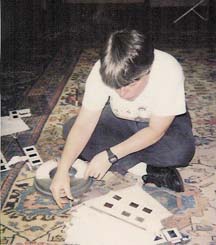 The Unit
is dedicated to the memory of Nancy Ashkar, a true local hero, shown below
working on Unit slides. What follows is a revision of her work and that of
the Wayland LSC by Bobby Robinson, former director of the Massachusetts Studies
Project. It is subject to further revision by teachers as the lessons are
used and evaluated. Thanks go to members of the Wayland Historical Society
who reviewed the Unit and assisted in locating resources: Jo Goeselt, Lois
Davis, Joanne Davis, Marnie Ives, Jane Sciacca, and Molly Faulkner. Technical
skills of Larry Nilsen in preparing several slides and Andy Robinson, in preparing
the Unit for website presentation, were invaluable.
The Unit
is dedicated to the memory of Nancy Ashkar, a true local hero, shown below
working on Unit slides. What follows is a revision of her work and that of
the Wayland LSC by Bobby Robinson, former director of the Massachusetts Studies
Project. It is subject to further revision by teachers as the lessons are
used and evaluated. Thanks go to members of the Wayland Historical Society
who reviewed the Unit and assisted in locating resources: Jo Goeselt, Lois
Davis, Joanne Davis, Marnie Ives, Jane Sciacca, and Molly Faulkner. Technical
skills of Larry Nilsen in preparing several slides and Andy Robinson, in preparing
the Unit for website presentation, were invaluable.
The Unit consists of the following lessons (7 class periods
and 3 field experiences): You can link to each lesson below but there is a
Unit sequence. You will note that Standards and Assessment procedures are
suggested with each lesson.
1. Introduction to the Civil War (2 class periods)
2. Setting the local scene (1 class period)
3. Selecting Town Characters & Preparing Biographies
(3 class periods)
4. Field Trip to see local Civil War sites (1/2 day
trip)
5. Preparation for Role Play (1/2 day field trip)
6. Final Preparation for Reunion Party (1 class period)
7. Culminating Event: Reunion Party at Historical Society house (2 hr
party)
8. Suggestions for Variations of Culminating Event
Appendix I: Massachusetts Standards for Unit
Appendix II: Bibliography and Curriculum Resources
WAYLAND IN THE
CIVIL WAR
LESSON 1. Introduction to the Civil War: (2 class periods)
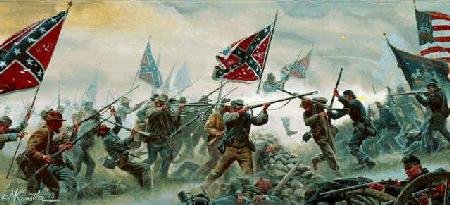
Essential Question:
What events led to the Civil War between the North and South?
Objectives:
Š Students
will consider events leading up to and during the Civil War, using the Internet
to search Civil War websites (period 1)
Š Students
will enter notes in a Civil War Journal (period 1)
Š Students
will report on their research (period 2)
Š Students
will develop a timeline for the Civil War (period 2)
Standards: (See
Appendix I for the text of the curriculum standards listed below:
(HSS standards
USI.31, 35, 36, 37) (HSS concepts 8-12.3)
(Technology competency skills)
Activity:
1. The first class is web search and note taking to provide
background on the Civil War. After an introduction to the Unit by the classroom
teacher, students work as a team of two or three on a selected or assigned
topic* In cooperation with the Media/Technology teacher, students search the
Internet in the Computer lab and find three facts to share and one date to put
on the class timeline. Students begin a Civil War Journal** with written
response to research on selected topic online.
2. Second class: each team has 3-5 minutes to report on
findings and website source and to put one date on a class timeline. Students
note in Journal useful websites from other student reports.
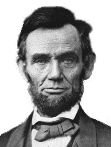
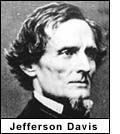
*15 topics for teams of two; (or
combine several topics for larger teams)
- Fugitive Slave Act
- Underground
Railroad
- Dred
Scott Decision
- Kansas-Nebraska
Act
- Harriet
Beecher Stowe’s Uncle Tom's Cabin
- John
Brown & Harper's Ferry
- Economic
Differences between South & North
- US
Census of 1860
- Election
of 1860 in US - issues and candidates
- Abraham
Lincoln inauguration & cabinet
- Election
of 1860 in MA (Governor, legislature makeup)
- South
Secession (Listing of states & Confederacy leadership)
- Fort
Sumter, beginning of war
- Seven
Days’ fighting of the Army of the Potomac
- Recruitment
for Union Army
- Timelines
of Civil War battles for later reference
Materials:
See Appendix II on Resources/Bibliography for suggested
Internet sites for research on topics and timeline
Assessment
Participation in second class: reporting results of research
and addition of Timeline dates on selected Civil War event.
Journals handed in after Class 2 for initial review by
teacher.
**Criteria for Journal notes:
Day 1
Student lists name and other member of team
Civil War topic
Websites searched
Notes taken on topic
Select three facts from notes for class presentation
Date(s) for class timeline
Day 2
Use three facts from Journal for presentation on topic and
timeline dates.
Notes of most useful Civil War websites from other team
reports.
LESSON 2.
Setting the Local Scene (1 class
period)
Essential Question:
What was Wayland (your community) like on the eve of the Civil War and how did
it become involved?
Objectives:
- Students
will understand basic facts about the history and geography of the town in
the context of the Civil War and add key local dates to Civil War
timeline.
- Students
will use map skills to locate major sites relating to 1860 Wayland (your
community)
Standards: HSS
standard USI.35, 36)
(HSS concepts 8-12.3, 8)
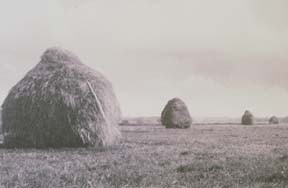
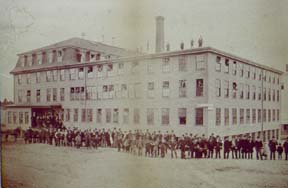
Activity:
A guest speaker from Wayland Historical Society provides
information on Wayland on the eve of the Civil War, ca 1860, using slides and
other visuals to relate to familiar scenes (shown above, haystacks and shoefactory)
. Background information is also contained in the handouts briefly reviewed by
speaker and provided to students for further research in developing a Town
Character. Wayland’s population was then 1188. It was mainly a farming
community in the north, with small-scale manufacturing and a changing
population as industry changed the south of town (Cochituate village), The
local response to larger issues of the day such as slavery is relevant. Wayland
voted in Presidential election for Lincoln, and for Andrews as Governor which
represented a pro-Union and anti-slavery attitude).*
A large 1875 map available from the Engineers Office is
displayed and students work on a 8 ½ x 11 copy of this map (see link
below) to locate major areas, landmarks during the Civil War period discussed
by the speaker (full page image wayland1875map.pdf) 15
Local Town Characters will be introduced who will be researched under Lesson
#3.
Materials Handed out
for lesson # 2, for class review and homework for lesson #3
Š “Life
in Wayland During the War Years”
Š Wayland background
information
Š Wm.
Shouler, Adjutant General, Massachusetts in
the Civil War, notes on cities and towns.
Š A.S.
Hudson, Annals of Sudbury, Wayland and Maynard: Town Slaves History, and Civil War
History: homework reading
Š Sermon by
Unitarian minister (1856), Slavery petition (1839)
Š List
of Town Characters (see lesson 3)
Journal criteria
Lesson 1. Notes from discussion in Civil War Journal.
Lesson 2. Notes on handouts as homework reading before next
class
Assessment
Journal notes
Locating Wayland landmarks on Civil War era map
*It may be difficult
to determine slavery attitudes in your town, other than for a few individuals.
Look for petitions, sermons, anti-slavery society memberships, and personal
letters that may reveal such attitudes and values. Wayland information is
sketchy and inferences have been made based on the vote for President and
Governor, letters from abolitionist Lydia Maria Child, sermons by the Unitarian
minister and earlier 1837 petitions initiated by the Trinitarian Congregational
minister. To extend the study of slavery and abolition in Massachusetts, see
Suggested Extension Activities in Lesson 8.
LESSON 3. Selecting and Writing Biographies of Civil
War Town Characters: (3 class periods)
Essential Questions: What contributions did local men make in the Union
armed services and local townspeople make on the home front?
How
do primary sources help students understand the roles of these local men and
women?
Objectives:
Š Students
will use writing skills to prepare a biography on a Town Character during the
Civil War period
Š Students
will understand the local context in order to prepare for role play of selected
characters
Š Students
will be able to distinguish between primary and secondary sources and view them
critically in preparing a biography, script and readings for a final Reunion
Party.
Standards: (HSS Concepts 3.3. 3.7, 8-12.3, 7, 8)
(ELA standards 8, 13, 18, 23)
Activity:
1. In the first lesson 15 Town
Characters will be assigned to teams of two students* with packets about each
character prepared by the LSC/teacher. Before students begin work in teams, the
whole class goes over the background materials from Lesson #2 which students
reviewed in their Journal as homework, including local chronological record and
report on war activities. Ask students to put local dates on the class timeline
and to discuss information that relates to their characters. Review the
questions to be asked of these characters from the “Guide to Writing
Biographies of Wayland Characters in the Civil War”. Pass out the Guide, the
summary about each character prepared by the LSC/teacher and the census
page for each character which they include in their packet. Have teams go over
contents together and begin writing notes in their Journal on their character.
Pass
out the packets for each character and have teams go over contents together and
begin writing notes in their Journal on their character.
2.
In class #2, teams select a primary
source(s) for readings at the Reunion Ceremony. (See listings of sources below)
The teacher reviews differences between primary and secondary sources and the
importance of considering the source for its particular point of view,
including bias. Teams review all materials in their packet and consider which
example would be most appropriate to accompany the role play of their
Character. For the purpose of the readings at the Reunion, it is possible to
select a paragraph or parts of a longer text. These readings will be mounted on
reading cards in a later lesson. Students go over background materials, notes
and readings as homework and continue writing their biography in their Journal.
3.
In lesson #3, teams spend 15 minutes going over their Journal biographical
notes together, then use remaining class time completing notes on their
character, to be handed in at the end of the class. (At this point two separate
biographies for each team character are produced, which they will later combine
and refine for Reunion Party role play script.)
Wayland Characters Include:
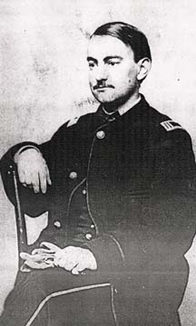
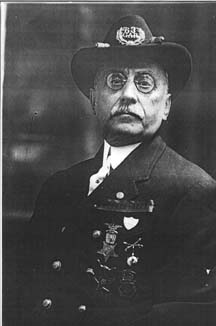
Battle
Front
Seven of the Wayland servicemen who went to War were selected
as Town Characters:
- Charles
Benjamin Butterfield,
shoemaker, 39th Regt. MA, taken prisoner (image above R)
- Charles
Henry Campbell,
farmer, 35th Regt. MA, became hospital assistant to wounded
- Thomas
Alfred Dean,
millworker, 45th Regt. MA & Cadet Regt.
- Frank
Winthrop Draper,
college graduate, 35th Regt. MA and officer in U.S. Colored 39th Regt.
(Image L)
- William
Henry Garfield,
shoe trimmer, 39th Regt. MA
- John
Noyes Morse,
college student and organist, 35th Regt. MA, became 1st Lieut.
- Thomas
Francis Wade,
career Navy man, Navy Capt. of USS Commodore Jones
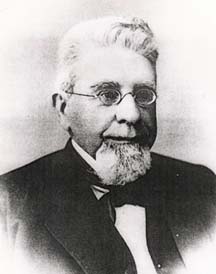
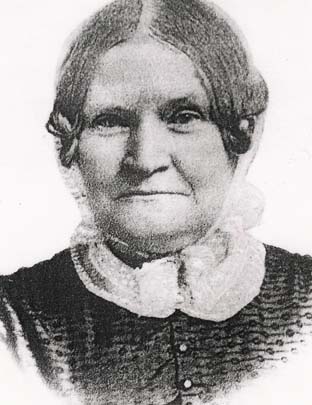
Home Front
Eight Wayland citizens
were selected as Town Characters
- James
Madison Bent,
Cochituate millowner (Shoe factory), active in town politics (image L)
- Lydia
Maria Child,
author, abolitionist who moved to Wayland to care for aging parents (image
R)
- Alfred
Wayland Cutting,
young neighbor of Child, included for understanding educational activities
during the Civil War; he later left photographs, writings about the town
- Lydia Rutter
Draper, high school principal who later married an historian of
Wayland
- William
Clapp Grout,
dairyman, organist, surveyor, town miller
- Newell
Heard,
from well-known Wayland family, shopkeeper and postmaster
- Edmund
Hamilton Sears,
Unitarian minister, abolitionist
- Dora
Thurston Whitney,
from Ireland, husband Hiram Leonard Thurston died in war leaving 4
children
Materials
for each team:
• Guide to Writing
Biographies of Wayland Characters in the Civil War
Each Wayland Character will have the
following personal materials if available:**
• Vital
Statistics
• Home location
• Picture of
person, and related photos
• Civil war
activities: if in service, what regiment etc. and any records of service;
chapter from
Memorial book
• Personal
letters, diaries, anecdotal information from this period
• Evidence of
occupation before, during & after war
• List of
College graduates from Wayland (if applicable)
*15 characters are based on a class size of 30, with teams of two members
each. If your class is smaller, select a smaller number of Town
Characters. If you do not use the
Wayland materials and develop your own Characters, the number in each group can
be revised depending on how many characters you are able to research. Even one
family can be a good start. For example, in Wayland, the Draper family left
papers behind about its men who went to war and family members who were active
in the community at that time. Suggestions for other approaches that may fit your
schedule or materials available are contained in Lesson 8.
**Personal
Information from Character packets summarized in biography links above.
Journal
Notes:
Lesson 1: Add
ideas, information from review of background information not already in your
notes
Begin Town
Character biography notes
Lesson 2:
Include selected reading(s) in Journal. As homework, begin writing biography
based on notes and readings.
Lesson 3:
Biography completed in class and handed in.
Assessment:
Class
participation
Written
Biography on Town Character
Follow-up:
Invitations are
sent home to invite families to final event to take place in the following
week(s)
Primary/Secondary Sources: (See Appendix II)
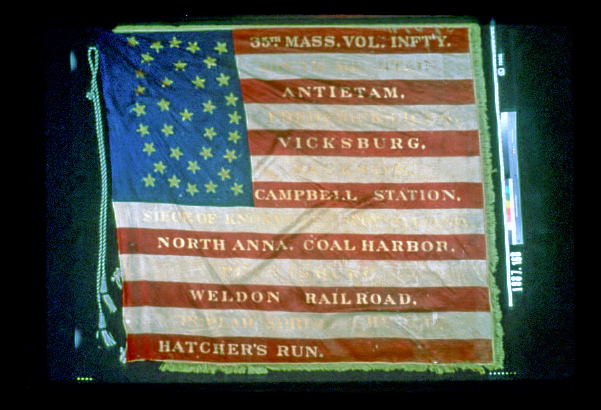
II. The War Front:
Because several of the Wayland men
served in the 35th
Regiment (including Campbell, Draper and Morse who are Town Characters) and
there is an excellent written history of that regiment, excerpts about the 35th
are reproduced online. A regimental flag recounts some of its battles. Although
the 39th also included some Wayland men (Butterworth) and 45th
(Dean), their regimental histories weren’t found. However, except for specific
battles, much of the 35th information can be used by others.
Lynnfield
Training: The call for troops and the organizing of the 35th and
departure for the war front. Sets the stage for all that follows and includes
references to support from the home town.
Antietam: The
complete chapter is transcribed which is long, but memorably written and worthy
of student study. The 35th went into battle almost immediately as a
green regiment. Antietam was only their second battle after service began, the
first at South Mtn, MD which was a quick victory. They were not prepared for
Antietam, a deadly confrontation that left over 10,000 dead for the Union and
12,000 dead for the Confederacy. Some of the bloom of patriotism wore off as
the realities of war set in.
Petersburg battle: This letter from Frank
Draper gives insight into the role of blacks fighting for the North in the
war.
Medicine, Hospitals: Charles Campbell shared his
experience as a hospital
assistant. Frank Draper of the 35th was assigned to hospital work (later
became a successful surgeon). His Memorial
descriptions reveal the horrors of war casualties and scathingly criticizes his
surgeon superior.
Prison Pens: Several of the Wayland men were
prisoners of war and reported on conditions (Butterworth,
e.g.) The report
from the 35th was not from a Wayland serviceman, but accurately
reflects conditions they all shared.
Wayland in the Civil War Memorial Excerpts: The Memorial provides testimonials about the men from Wayland who
served in the Civil War, and includes stories and quotes from interviews with
many of the 69 men covered, as well as a chronological listing of Civil
War battles in which Wayland soldiers participated. This may be the only memorial of its kind in MA to
come out of the post-war celebrations for returning veterans. Most cities and
towns chose to erect a statue. Sections on the men selected as Town Characters
were Xeroxed for the student study packets and some quotes are included in
character links above. The Memorial
also included information on the Wayland role during the war (home front
below).
Home Front
Vol. II of Adjutant General Wm. Shouler, Massachusetts in
the Civil War, on the Cities and Towns,
informs about federal-state-local relationships, recruitment quotas, bounties,
responses of the communities (Wayland), names of local selectmen.
Wayland Town meetings, efforts at recruitment; information
provided in Call to War
and Wayland
statistics accounts
Rev. Sears
sermon on slavery (1856)
Petition against
slavery (1837)
Attitudes toward Slavery: Lydia Maria Child letters also describes Wayland
attitudes from her perspective as an abolitionist, writer.
Alfred Wayland Cutting quotes: Old-time Wayland is a
later view of the center because Cutting was just a boy during Civil War, but
it is still a good description. Childhood Memories
about the Child family.
Bent
Shoe Factory and Cochituate
The 4th of July
celebration 1965 welcomed home the men. The program included:
Introduction by James Sumner Draper, excerpts
Rev. Edmund H. Sears address, excerpts
Poem by R. F. Fuller, Esq.
LESSON 4. Field Trip to see local Civil War sites (1/2 day field trip)
Essential Question: What
did my Town look like in Civil War times and what evidence remains today?
Objective:
- Students
will gain experiential knowledge of the land and characters of Wayland in
the Civil War through a tour of sites that provides additional background
for their Town Character role
- Students
will hone their map skills in locating cemetery and house sites of Town
Character.
Standards:
(HSS
concepts 7.1, 8-12.8)
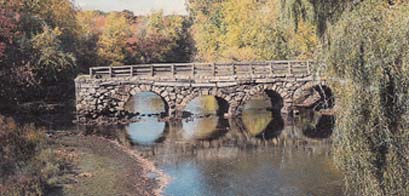
Activity:
1. A Civil War bus tour is undertaken in cooperation with
Wayland LSC and teacher(s). The LSC has developed the route with annotated
stops that relate to Town Characters and town structures still standing from
the 1860s. Building on the
previous lesson using town maps and the Town Character packet that listed home
location, teams learn where their Character lived, and they mark it on a modern
town map. If Character was buried in Wayland, they locate gravesite at either
of two cemeteries and mark it on the map. The LSC or teachers will scout out
gravesites in advance and provide sketches or put in markers for clues. On this
same modern Wayland map students place other Civil War landmarks. Team members
continue to take notes in their Civil War Journal to flesh out their character.
*In the Wayland program the bus tour ends at the Historical
Society house where students eat their box lunch before starting the second
half of the tour working on their role play script and characterization.
(Lesson 5).
Materials: Wayland Bus Tour Route and Annotations * along with
tour map with house sites. (If you develop your own tour, this can
serve as a model but can be simplified.
Summaries developed on Town Characters may help to determine
house locations.
Cemetery records will be invaluable. Your engineer's office
will have a map for the Civil War period which will help you locate major local
landmarks of period. (If not available, use Beers Atlas of 1875)
Journal:
Notes that relate to Town Character and major sites of the
period.
Assessment:
Journal work
Final event will have rubric that includes preparation
(including bus tour) and performance of character and readings.
*If local field trips are not allowed, plan a “virtual tour” at school with slides of houses and landmarks. Local historical organization’s involvement will be helpful. An interrelationship between the schools and the town's cultural institutions can still be encouraged and lead to future collaboration.
LESSON 5. Role Play Preparation for Culminating Event: (1/2 day field trip, with above #4)
Objective: Students
will use language arts skills for script preparation and creative arts for costume
& character identification through artifacts, props.
Standard:
(HSS concepts 3.3, 8-12.8)
ELA standards
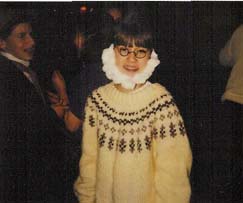
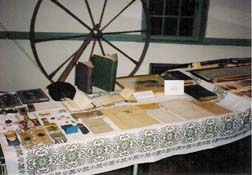
Activity:
Following the bus trip there is a lunch stop at the Wayland
Historical Society house. If you are not able to take a full-day field trip,
alternate arrangements can be made for a separate half-day
1. Preparation for final event follows. This activity builds
on biographical work from lesson 3 and the field trip tour, using Journal notes
to write a script for what Town Characters will say at the Reunion Party. In
addition to role play script, slides, artifacts and costumes will be needed to
enhance performance. Working with the teacher and Local Studies Center and
Historical Society helpers, work can be divided as follows:
2. Teamwork— Possible division: Each team can
decide among themselves who will perform as a Character at the Reunion event
and who will serve as the “production manager” who also has a reading. One
student works with the teacher or assistant on script and selects slides
relating to Town Character with Historical Society assistant. The second
student works with Historical Society helper on developing ideas for an
appropriate costume and identifying an artifact or prop that relates to team’s
Town Character (slide or reproduction for performance). Second team members
will also have a section of reading for the event. Since the two partners in
each team work separately, they will combine their efforts at the end of the
session. The notes from both are included in the written script. Team members
get together for last 1/2 hr. to compare notes to get ready for next class and
follow-up preparation at home on costumes, props.*
Character artifacts and general props: The Wayland
Historical Society has family artifacts relating to this period, such as
photographs, a Civil War cane, rifle, bullets, memorabilia picked up in the
South (slave bill of sale e.g.), gun cap, hats, freeman’s badge, etc. They have
costumes for students to look at and make notes about and websites also are
helpful. Civil War Roundtables in your area are often involved in reenactments
and have artifacts and props as well. Website listings with useful visuals are
included in the Bibliography Appendix II.
3. Order of Final Program: Sample of Wayland program
attached. The characters spoke in groups under a topic (Soldiers in the 35th,
Others who served in the War, Homefront Organizers, the Business of the
Community during the War, etc.) Readings are selected to be interspersed on the
program. This is flexible according to emphasis.
Materials:
Resources/Bibliography listing of website information on
Civil War costumes, music, uniforms, guns, drums. etc. (A complete costume or
uniform may not be possible but hats, wigs and other distinguishing aspects of
Character’s clothing can be created.)
Journal criteria:
Script on Town Character, including selection of slides for
the program (team member #1)
List of props, artifacts, selection of reading (team member
#2)
(shared by both)
Assessment :
Final event will have rubric of performance and production
elements (slides, props) related to combined effort and teamwork.
Each Journal should reflect combined efforts as well.
Essential Question:
What were my Town Character and the world he/she lived in really like?
Objective:
- Students
will use technology, historical context and language arts skills to put
Character script and program materials into final form.
Standards: (HSS
Concept 8-12.8)
(ELA standards19, 23, 24)
Technology competency skills
Activity:
This lesson takes place in the Media/Technology lab. Teacher
reviews plans for Reunion event (how organized, order of readings and
characters, music selected etc.) Technology teacher assists with instruction
for computer processing and printing of scripts developed at Historical Society
from biography notes, bus tour, Journal. Team member who is role playing a
Character word processes final script. Printing should be large enough for easy
reading at Reunion event. Team member assigned a reading makes copies of text
and visuals of costumes and props (if not Wayland originals and visuals).*
Those without a reading help reproduce the Program handouts. Teacher reviews
final script, costumes, props etc. with each team.
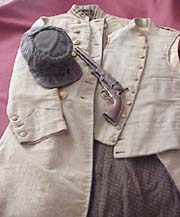
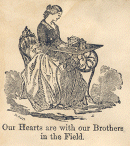
The Reunion Program is word
processed and printed. The Wayland program has already been discussed as a
model in the previous lesson. If you develop your own program, the class can
agree on the groupings for role-play and where to include your readings. The
MSP suggests a grouping that schedules the service men in sections with the war
readings and town characters with local readings, perhaps alternating between
the two groups.
Materials completed
at end of class:
Copy of printed script and printed reading for practice
before event
Copy of program to remind where each team takes part
(Characters and readings)
Journal criteria:
Reminder notes of each teammate's task at the Reunion party
Assessment:
Final event will have rubric of performance and production
elements (slides, props) related to combined effort and teamwork.
*Home Front image from Civil War Cover: http://www.chs.org/cwc/cwimages/cwc72.html
from digital collection of Connecticut Historical Society. Wayland has several
of these covers on U.S. mail envelopes.
LESSON 7. Culminating Event: Reunion Party (One evening 2 hr). (Wayland LSC images)
Essential Question:
How can students demonstrate their abilities to see a pivotal event in American
history, the Civil War, through local eyes?
Objectives:
- Students
will demonstrate their understanding of the role of the Town in the
context of the Civil War period through producing a Reunion event that
brings together Town Characters.
- Students
will make connections between Civil War events and ideas and post-war
effects on the town’s social, economic and political development
- Students
will be able to interpret past Civil War activities and post-war effects
through using research, writing, role playing and technology skills.
- Students
will improve teamwork skills in working on a Town Character.
- Students
will make community contacts and be able to identify educational resources
available within the community.
Standards: (HSS
Concepts 3.3, 3.7, 8-12.7, 8-12.8)
(HSS standard USI.40
(ELA standards 3, 18)


Activity:
1. In Wayland the final event takes place at the Historical
Society headquarters, the Grout-Heard House, (see variations) with parents
invited. The Society provides hosts to welcome the teacher(s), students and
their families, and offers refreshments.
Parents are formally welcomed by a costumed character (Sarah Heard) who
lived in the Historical Society house (Grout-Heard House) during the Civil War.
She provides the introduction to the local Civil War and post-war setting and
introduces the first Characters.*
2. Students perform their roles and readings in a finished
production. Artifacts are on display (including LM Child’s bonnet on table, L).
The Reunion takes place 10 or more years after the end of the Civil War*, and
Town Characters reflect on their wartime participation and their life after the
war’s end. Students role-play
their Characters who are grouped under a topic (“Soldiers in the 35th”,
“Others who served in the Military”, “Homefront Organizers”, “Economic
Activities during the War”, “Neighborhood perspectives” etc.) Other students take part with readings
that deal with quotes from military and local history sources. Music is played
at intervals during the program.* All of the same activities can take place at
the school or neutral site if the historical setting is not available, but
students might need to be more creative in finding props, designing scenery.
(Help from Art Dept.? and website search)
*In Wayland the reunion date chosen
was 1880 which reflected certain events in the town. The MSP selects the date
of 1876 which is the centennial of the nation and a time when many local
histories have been written and Civil War memories are still being revealed in
letters and articles. Fewer townspeople have died. Civil War veterans are
beginning to organize reunions of their own. The introduction by a historical
character makes friendly note of those present and reviews the after effects of
the war.
Materials:
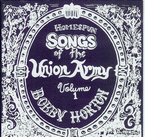 Welcome by Sarah
Heard Reunion Introduction
Welcome by Sarah
Heard Reunion Introduction
Sample of Wayland program
Music: Tapes are readily available; see Resources in
Appendix.
*Wayland used “Civil War Songs” and “Homespun Songs of the
Union Army”, and ”Homespun Songs
Assessment:
Sample Rubric attached that
covers objectives for Lessons 4-7 above
LESSON 8. Suggestions for Variations of Final Event
and Extension Activities
If the suggested culminating activities are not possible,
consider these community-based alternatives:
Š Prepare
a Community Newspaper and have students cover several dates important in the town’s
and the nation’s Civil War experience.
Š Research
the slavery question as it relates to the war and also to the local/state
scene. See sample lessons and resources in Bibliography. Many Mass. Blacks
served in the war and their deeds and treatment are recorded. Wayland had a
local connection to the 54th Colored Regiment through Robert Gould
Shaw’s family (property in Wayland and friend of L.M. Child) and to the 39th
Colored Regiment through Frank Draper.
Š Produce
a Panel Discussion among soldiers, using information on regiments served in
by members of the community. Local men fought at Antietam. Research this battle
online.
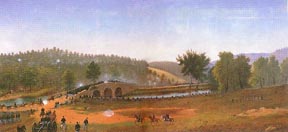
Š Produce
a self-guiding trail guide to Civil War sites in the community.
Š Study
educational conditions in the North during the war. Alfred W. Cutting was a young boy during the war and a
teenager by the time of the reunion. Although he probably attended a private
academy in Boston, there are references to what it was like in the Wayland
district school in those days. Patriotism was stressed in Massachusetts. The
South didn’t fare as well with educational opportunities. See Bibliography.
Š Provide
a program of Civil War music and explanations of their meaning, importance,
etc., bringing in local references.
Š Investigate
Civil War news and images: the impact of photography; how the local folks got
the news and reacted to it. One
place in Wayland where the newspapers arrived was at the Red Store of Newell
Heard. Many lessons have been developed around Matthew Brady & Civil War photographers.
See Joy Hakim reference, e.g.
Š Critically
study cartoons that reflect, explain Civil War attitudes, South & North
which have been published. Students can draw their own based on examples and
readings. See sample lessons that help develop this activity. Find out what
newspapers, magazines local people could read.
Š  Status of Medicine in the Civil War. At least two Wayland
men (Charles Campbell and Frank Draper) worked in the hospitals and their
letters reveal much about conditions and causes of death. Wayland women rolled
bandages at home for the hospitals Find out about the Sanitary Commission
work and the role of women at the front as nurses (Clara Barton, Louisa Alcott,
e.g.), Walt Whitman wrote about his nursing duties at the front. See Resource
listings.
Status of Medicine in the Civil War. At least two Wayland
men (Charles Campbell and Frank Draper) worked in the hospitals and their
letters reveal much about conditions and causes of death. Wayland women rolled
bandages at home for the hospitals Find out about the Sanitary Commission
work and the role of women at the front as nurses (Clara Barton, Louisa Alcott,
e.g.), Walt Whitman wrote about his nursing duties at the front. See Resource
listings.
More ideas can be found from suggested lessons in the bibliography
that develop alternative activities. Many are not specifically related to
communities but can be localized.